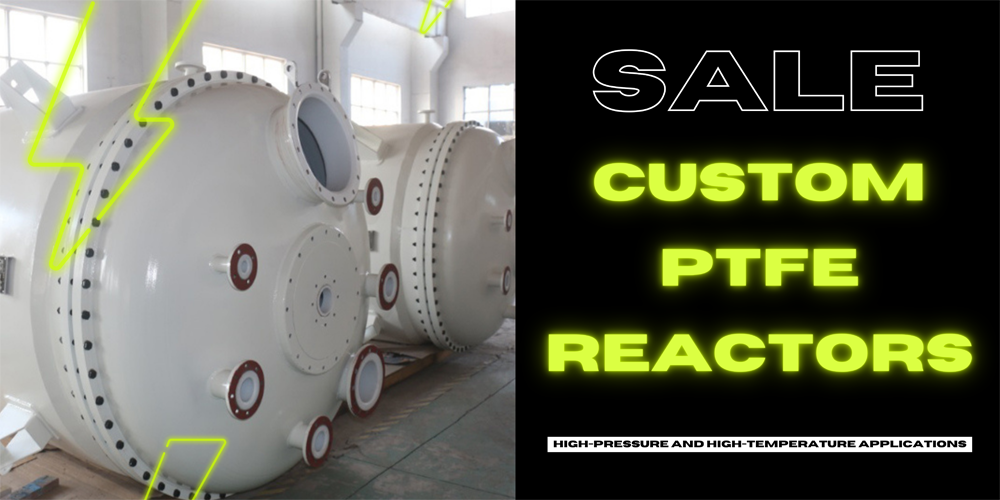
Polytetrafluoroethylene (PTFE), commonly known by the brand name Teflon, is a synthetic fluoropolymer renowned for its exceptional chemical resistance, high-temperature stability, and low friction properties. These attributes make PTFE an ideal material for manufacturing custom reactors used in high-pressure and high-temperature applications across various industries. This article explores the challenges, design considerations, and applications of custom PTFE reactors, focusing on their use in demanding industrial processes.
High-pressure and high-temperature reactions present unique challenges that necessitate the use of specialized materials and designs. Traditional materials like stainless steel or glass often fall short under extreme conditions, where PTFE offers several advantages. However, even PTFE, despite its robustness, faces specific challenges that must be addressed.
While PTFE is highly resistant to most chemicals, it can degrade in the presence of certain substances at elevated temperatures. For instance, strong oxidizers can cause PTFE to break down, limiting its use in some high-temperature oxidation processes. Additionally, PTFE's mechanical properties can diminish at very high temperatures, requiring reinforcement or blending with other materials to maintain structural integrity.
| Material | Chemical Resistance | Temperature Range (°C) | Mechanical Strength |
| PTFE | Excellent | -200 to 260 | Moderate |
| Stainless Steel | Good | -200 to 800 | High |
| Glass | Limited | -50 to 500 | Low |
Safety is paramount in high-pressure and high-temperature operations. PTFE's non-reactive nature reduces the risk of dangerous reactions within the reactor, but the design must also account for the material's lower mechanical strength compared to metals. Ensuring that PTFE reactors can withstand high pressures without deformation or failure is crucial. This often involves reinforcing PTFE components with materials like stainless steel or incorporating design features that distribute stress more effectively.
Designing custom PTFE reactors involves careful consideration of various factors to optimize performance and ensure safety under extreme conditions. Key considerations include the selection of appropriate PTFE grades, effective sealing mechanisms, and enhancements for heat transfer.
PTFE is available in several grades, each tailored for specific applications. PTFE, for example, offers the highest chemical resistance but may lack the mechanical strength required for high-pressure applications. Filled PTFE, which incorporates materials like glass fibers, carbon, or graphite, provides enhanced mechanical properties while maintaining good chemical resistance.
| PTFE Grade | Chemical Resistance | Mechanical Strength | Common Applications |
| PTFE | Excellent | Moderate | General chemical processes |
| Glass-filled PTFE | Very Good | High | High-pressure applications |
| Carbon-filled PTFE | Good | Very High | Abrasive environments |
Reinforcement is another critical aspect. Custom PTFE reactors often use a combination of PTFE with a metal casing or lining to provide the necessary structural support while maintaining the chemical inertness of PTFE in the reactor's interior.
Effective sealing is vital to prevent leaks and maintain the integrity of the reactor under high pressures. PTFE's low friction and excellent sealing properties make it suitable for gaskets and seals, but the design must ensure that these components can withstand both the chemical environment and the mechanical stresses involved.
Various sealing techniques, such as O-rings, lip seals, and composite seals, are employed based on the reactor's operating conditions. For high-pressure applications, backup rings made of more robust materials may be used alongside PTFE seals to prevent extrusion and ensure longevity.
Heat transfer efficiency is crucial in reactors operating at high temperatures. While PTFE itself has low thermal conductivity, reactor designs can incorporate features to enhance heat transfer. For instance, incorporating metal inserts or using PTFE-coated heat exchangers can improve heat distribution within the reactor. Additionally, external heating elements or jackets can be used to maintain the desired temperature profiles.
Custom PTFE reactors are employed in a variety of industries where high-pressure and high-temperature conditions are common. These applications leverage the unique properties of PTFE to ensure process reliability and efficiency.
In the petrochemical industry, custom PTFE reactors are used for processes such as alkylation, polymerization, and catalytic reactions. The chemical resistance of PTFE ensures that the reactors can handle aggressive reagents and solvents, while their non-stick properties help prevent fouling and buildup of reaction by-products.
Polymerization reactions, particularly those involving fluoropolymers or other specialty plastics, benefit from the use of PTFE reactors. The ability to maintain high purity levels and avoid contamination is critical in these processes, and PTFE's inertness and low friction make it ideal for such applications.
Supercritical fluid extraction (SFE) processes, which often operate at high pressures and temperatures, also utilize custom PTFE reactors. PTFE's resistance to supercritical fluids, such as CO2, allows for efficient extraction of target compounds from complex mixtures without degradation of the reactor material.
As industries continue to push the boundaries of chemical processing, the demand for advanced reactor materials and designs will grow. Future trends in custom PTFE reactors include the development of new PTFE composites, the integration of sensors and automation, and the exploration of novel reactor configurations.
Research into PTFE composites aims to enhance the material's mechanical properties and extend its temperature range. Innovations such as nano-fillers or hybrid composites could provide significant improvements in strength and durability, making PTFE reactors even more versatile.
The integration of sensors and automation in PTFE reactors can enhance process control and safety. Advanced sensors can monitor temperature, pressure, and chemical composition in real-time, allowing for immediate adjustments and optimization. Automation systems can further ensure that reactors operate within safe parameters, reducing the risk of accidents and improving overall efficiency.
Custom PTFE reactors play a crucial role in high-pressure and high-temperature applications across various industries. By addressing the challenges associated with extreme conditions through careful material selection, robust design, and innovative enhancements, these reactors enable efficient and safe chemical processing. As technology advances, the continued development of PTFE materials and reactor designs will further expand the capabilities and applications of these essential tools in industrial processes.
In summary, the unique properties of PTFE, combined with tailored design considerations, make custom PTFE reactors indispensable for high-pressure and high-temperature applications. With ongoing research and technological advancements, these reactors are poised to meet the evolving demands of the chemical processing industry, ensuring continued innovation and efficiency.
Feel free to leave your message on our board. If you're looking to inquire about prices or place an order, this is the right place! Let us know the details of your needs, and our team will get back to you with a personalized quote as quickly as possible. We're here to ensure your experience is seamless and satisfactory. Share your requirements or ask any questions you might have - we're eager to assist and look forward to doing business with you!
Name:Tim
Phone:+86-15716151880
Email:[email protected]
Company:BEANT
Address:No. 28, Luoshen Road, Luoshe Town, Huishan District, Wuxi City, Jiangsu Province
